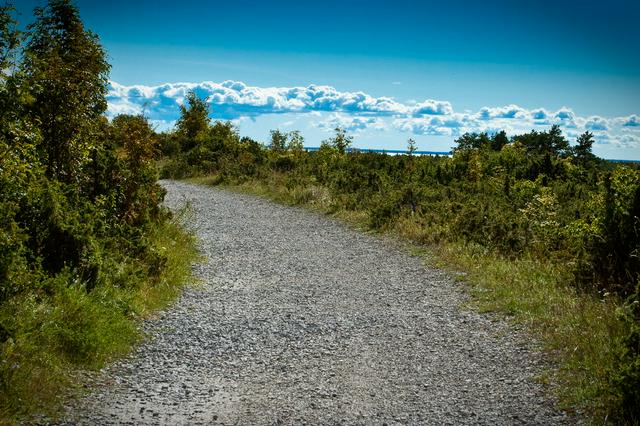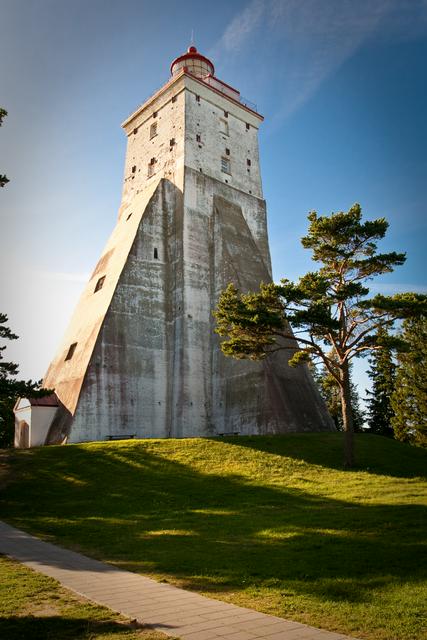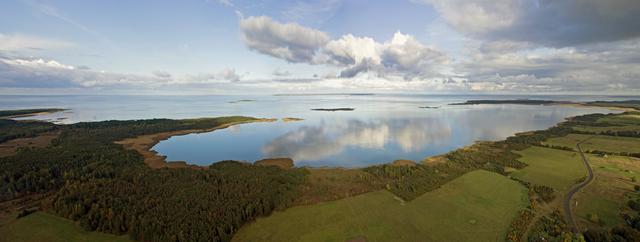 Hiiumaa is the second biggest island in Estonia. The Swedish and German name of the island is Dagö.
Hiiumaa is the second biggest island in Estonia. The Swedish and German name of the island is Dagö.
- Kärdla.
- Käina.
- Kõrgessaare.
Kärdla.
Käina.
Kõrgessaare.
Hiiumaa is just north of Saaremaa Island and west of the mainland. Formed 455 million years ago as a result of a meteorite explosion Hiiumaa is one of the oldest islands in the world, and known for its wealth of lighthouses.
The people of Hiiumaa are peaceful and tolerant. They live close to nature and have their own language – Hiiu, even though basically all also speak Estonian. Also spoken by many are Russian, English, German and Finnish.
The most important thing to remember about the people is their sense of humor – they like to laugh at themselves and love all kinds of jokes - especially the ones about their neighbours (the people of Saaremaa).
The tourist information is located in Kärdla.
Thanks to the surrounding sea, the climate on Hiiumaa is a bit different from the one on the continent. There are more sunny days and less rainy days. Best time to visit Hiiumaa is from May to September. If you would like to sunbathe it is recommended to visit in July or August.

- Kõpu Lighthouse, Kõpu küla, Kõrgessaare vald, +372 5299162. daily 10:00–20:00. The highest hill (68 m) of Hiiumaa, the Tornimägi, is the location of the lighthouse. Due to the very important shipping lane, the Hanseatic Merchants League was very interested in making this dangerous passage through shallow reef safer. In 1500, the magistrate of Tallinn obtained permission from Bishop John III Orges to build a landmark here. In 1531, after having chosen the highest hill of Hiiumaa, the massive stone tower was finised, from which this lighthouse was later derived. The construction was interrupted several times by the plague, which is why it took 30 years before completion. Already back then the turret was shaped like a four-legged prism, which was supported by massive counter-forces by the four main corners. Kõpu is the third-oldest constantly active lighthouse worldwide. €2/1 (adult/discounted) per lighthouse, or €5/2 for all 3.
- Tahkuna Lighthouse, Tahkuna küla, Kõrgessaare vald, +372 56919583. Mai–Sep 10–19:00. The construction of the cast iron lighthouse began in 1873. Made in Paris, it was brought to Hiiumaa in parts. Two beacons were ordered in Paris – the other one was used for the Ristna lighthouse. Tahkuna and Ristna are the newer ones and stem from the period when iron was used instead of stone, like for Kõpu. In 1941, fighters of the Soviet Army surrendered to the Germans at the foot of this lighthouse. Tahkuna is the highest lighthouse in Estonia - 42.6 m above sea level. It can be seen from a distance of 33 km. €2/1 (adult/discounted) per lighthouse, or €5/2 for all 3.
- Ristna Lighthouse, +372 5243824. May–Sep 15: Tu–Su 10–19:00. Smaller and less impressive, but nice and architecturally interesting, at the westernmost point of the Kõpu peninsula. The light 37 m above sea level can be seen at a distance of 31.5 km, which is less than the 50 km of the 102 m above sea level light of the Kõpu lighthouse. The Ristna lighthouse was erected in 1874 from parts brought from France. In 1915, German war ships attacked the lighthouse, severely damaging it. In the following, in was supported with a concrete belt in 1920. €2/1 (adult/discounted) per lighthouse, or €5/2 for all 3.
Kõpu Lighthouse, Kõpu küla, Kõrgessaare vald, +372 5299162. daily 10:00–20:00. The highest hill (68 m) of Hiiumaa, the Tornimägi, is the location of the lighthouse. Due to the very important shipping lane, the Hanseatic Merchants League was very interested in making this dangerous passage through shallow reef safer. In 1500, the magistrate of Tallinn obtained permission from Bishop John III Orges to build a landmark here. In 1531, after having chosen the highest hill of Hiiumaa, the massive stone tower was finised, from which this lighthouse was later derived. The construction was interrupted several times by the plague, which is why it took 30 years before completion. Already back then the turret was shaped like a four-legged prism, which was supported by massive counter-forces by the four main corners. Kõpu is the third-oldest constantly active lighthouse worldwide. €2/1 (adult/discounted) per lighthouse, or €5/2 for all 3.
Tahkuna Lighthouse, Tahkuna küla, Kõrgessaare vald, +372 56919583. Mai–Sep 10–19:00. The construction of the cast iron lighthouse began in 1873. Made in Paris, it was brought to Hiiumaa in parts. Two beacons were ordered in Paris – the other one was used for the Ristna lighthouse. Tahkuna and Ristna are the newer ones and stem from the period when iron was used instead of stone, like for Kõpu. In 1941, fighters of the Soviet Army surrendered to the Germans at the foot of this lighthouse. Tahkuna is the highest lighthouse in Estonia - 42.6 m above sea level. It can be seen from a distance of 33 km. €2/1 (adult/discounted) per lighthouse, or €5/2 for all 3.
Ristna Lighthouse, +372 5243824. May–Sep 15: Tu–Su 10–19:00. Smaller and less impressive, but nice and architecturally interesting, at the westernmost point of the Kõpu peninsula. The light 37 m above sea level can be seen at a distance of 31.5 km, which is less than the 50 km of the 102 m above sea level light of the Kõpu lighthouse. The Ristna lighthouse was erected in 1874 from parts brought from France. In 1915, German war ships attacked the lighthouse, severely damaging it. In the following, in was supported with a concrete belt in 1920. €2/1 (adult/discounted) per lighthouse, or €5/2 for all 3.
- Hiiumaa Military Museum, Tahkuna nina, Tahkuna küla, Kõrgessaare vald, Hiiu maakond, +372 56276020, +372 53479819. May 15–Sep 15: Tu–Su 10–18:00. The crown jewel of the exhibition is the BB-316 cannon barrel from the Tahkuna Kukeraba battery. The museum exhibition covers Hiiumaa’s coastal defence structures, armaments, and ammunition. In a simulated barracks, visitors can examine surveillance and communications equipment. There is a reconstruction of a border strip in the yard. €3/1.50 (adult/discounted).
- Hiiumaa Museum Kassari Exhibition House, Kassari küla, Käina vald, +372 5232225. May-Aug: daily 10–18:00, Sep: daily 10–17:00. There are items dating from the Tsarist, Estonian, and Soviet periods related to maritime history, as well as the history of agriculture and the manors. There is also much to see outside – a lifeboat from the SS Estonia, the Kassari school flagpole, manor’s lawn roller, etc. Prices see Hiiumaa Museum Long House.
- Rudolf Tobias House Museum, Hiiu maantee 33, Käina alevik, Käina vald, +372 4632091. Sep–Jun 13: by appointment; summer: W-Sa 11:00–17:00. The house, built in 1839 in Käina, is one of the oldest small town residences in Estonia. The exhibition in the composer’s birthplace provides a detailed overview of Tobias’s life and works. Prices see Hiiumaa Museum Long House.
- Mihkli Farm Museum, Malvaste küla, Kõrgessaare vald, +372 4632091. May 14–Aug: W–Su 11:00–18:00, Sep–May 13: by appointment. The Hiiumaa open-air museum introduces local architecture and artefacts from the 19th century. The spacious courtyard is a perfect place for various activities, from tar burning in summer to "Christmas land" in winter. A visit to the unique smoke sauna or a picnic on the edge of the forest are just some additional services the museum is offering. Prices see Hiiumaa Museum Long House.
Hiiumaa Military Museum, Tahkuna nina, Tahkuna küla, Kõrgessaare vald, Hiiu maakond, +372 56276020, +372 53479819. May 15–Sep 15: Tu–Su 10–18:00. The crown jewel of the exhibition is the BB-316 cannon barrel from the Tahkuna Kukeraba battery. The museum exhibition covers Hiiumaa’s coastal defence structures, armaments, and ammunition. In a simulated barracks, visitors can examine surveillance and communications equipment. There is a reconstruction of a border strip in the yard. €3/1.50 (adult/discounted).
Hiiumaa Museum Kassari Exhibition House, Kassari küla, Käina vald, +372 5232225. May-Aug: daily 10–18:00, Sep: daily 10–17:00. There are items dating from the Tsarist, Estonian, and Soviet periods related to maritime history, as well as the history of agriculture and the manors. There is also much to see outside – a lifeboat from the SS Estonia, the Kassari school flagpole, manor’s lawn roller, etc. Prices see Hiiumaa Museum Long House.
Rudolf Tobias House Museum, Hiiu maantee 33, Käina alevik, Käina vald, +372 4632091. Sep–Jun 13: by appointment; summer: W-Sa 11:00–17:00. The house, built in 1839 in Käina, is one of the oldest small town residences in Estonia. The exhibition in the composer’s birthplace provides a detailed overview of Tobias’s life and works. Prices see Hiiumaa Museum Long House.
Mihkli Farm Museum, Malvaste küla, Kõrgessaare vald, +372 4632091. May 14–Aug: W–Su 11:00–18:00, Sep–May 13: by appointment. The Hiiumaa open-air museum introduces local architecture and artefacts from the 19th century. The spacious courtyard is a perfect place for various activities, from tar burning in summer to "Christmas land" in winter. A visit to the unique smoke sauna or a picnic on the edge of the forest are just some additional services the museum is offering. Prices see Hiiumaa Museum Long House.
- Kuriste Church, Kuriste küla, Käina vald, Taterma, +372 5090251. The Estonian Orthodox Hiiumaa Church of the Birth of the Mother of our Lord was completed in 1873. Icons and liturgical textiles from the end of the 19th and beginning of the 20th centuries are on display. The church is the only Orthodox church to have survived in Hiiumaa, where services also still take place.
- Pühalepa Church, Suuremõisa küla, Pühalepa vald. It's the oldest stone church in Hiiumaa.
- Käina church ruins, Hiiu maantee, Käina alevik, Käina. The biggest church in Hiiumaa was built at the turn of the 15th-16th century and was destroyed in 1941. Several tombstones as well as the sun cross above the entrance are protected as art monuments.
- Reigi Church, Pihla küla, Kõrgessaare vald. The greatest treasure of the Reigi Church is its art collection.
Kuriste Church, Kuriste küla, Käina vald, Taterma, +372 5090251. The Estonian Orthodox Hiiumaa Church of the Birth of the Mother of our Lord was completed in 1873. Icons and liturgical textiles from the end of the 19th and beginning of the 20th centuries are on display. The church is the only Orthodox church to have survived in Hiiumaa, where services also still take place.
Pühalepa Church, Suuremõisa küla, Pühalepa vald. It's the oldest stone church in Hiiumaa.
Käina church ruins, Hiiu maantee, Käina alevik, Käina. The biggest church in Hiiumaa was built at the turn of the 15th-16th century and was destroyed in 1941. Several tombstones as well as the sun cross above the entrance are protected as art monuments.
Reigi Church, Pihla küla, Kõrgessaare vald. The greatest treasure of the Reigi Church is its art collection.
- Hill of Crosses. By far not as impressive as the Lithuanian equivalent, but good for a stop if you go by anyhow. There is a carpark just nearby. The first cross stemmed from the Swedes in 1781 that had to leave Hiiumaa due to an order of Czarina Katarina II. They were expelled from their farms and supposed to resettle in Ukraine. However, because they had to start their journey in winter, only half of the 1000 people reached the destination at the then later founded Gammalsvenskby village. Finally in 1929, the descendents of these Swedes where allowed by the Soviet Russia to return to Sweden. Most went to Gotland. All following crosses were erected by visitors in remembrance of these Swedes and their difficult journey.
- Suuremõisa castle, Suuremõisa küla, Pühalepa vald, +372 4694267, +372 5158381. M-F 10:00–16:00. The present manor house was built by the Countess Ebba Margaretha Stenbock. Suuremõisa Castle is one of the most beautiful and biggest manor houses in Estonia. The value of the castle lies in its pure Baroque-Rococo style. You can follow a wonderful trail to get to know the manor park. The manor house also accommodates Suuremõisa Technical School and Suuremõisa Primary School. Also includes a restaurant open longer. €2/1.50 adult/discounted.
- Sõru port, +372 5272865. Services the ferryboat traffic between Saaremaa and Hiiumaa.
- Orjaku port. No official ferries, just private traffic. But the port is quite picturesque.
- Motor sailboat Ernst Jaakson, Pärna küla, Emmaste vald. Built in 1937–1939, the 35-metre-long and 8-metre-wide three-masted motor sailboat Ernst Jaakson (Alar) is the largest "old" boat to survive in Estonia.
Hill of Crosses. By far not as impressive as the Lithuanian equivalent, but good for a stop if you go by anyhow. There is a carpark just nearby. The first cross stemmed from the Swedes in 1781 that had to leave Hiiumaa due to an order of Czarina Katarina II. They were expelled from their farms and supposed to resettle in Ukraine. However, because they had to start their journey in winter, only half of the 1000 people reached the destination at the then later founded Gammalsvenskby village. Finally in 1929, the descendents of these Swedes where allowed by the Soviet Russia to return to Sweden. Most went to Gotland. All following crosses were erected by visitors in remembrance of these Swedes and their difficult journey.
Suuremõisa castle, Suuremõisa küla, Pühalepa vald, +372 4694267, +372 5158381. M-F 10:00–16:00. The present manor house was built by the Countess Ebba Margaretha Stenbock. Suuremõisa Castle is one of the most beautiful and biggest manor houses in Estonia. The value of the castle lies in its pure Baroque-Rococo style. You can follow a wonderful trail to get to know the manor park. The manor house also accommodates Suuremõisa Technical School and Suuremõisa Primary School. Also includes a restaurant open longer. €2/1.50 adult/discounted.
Sõru port, +372 5272865. Services the ferryboat traffic between [[Saaremaa]] and Hiiumaa.
Orjaku port. No official ferries, just private traffic. But the port is quite picturesque.
Motor sailboat Ernst Jaakson, Pärna küla, Emmaste vald. Built in 1937–1939, the 35-metre-long and 8-metre-wide three-masted motor sailboat Ernst Jaakson (Alar) is the largest "old" boat to survive in Estonia.
 In Estonia it is difficult to find a place with more picturesque nature than on the island Hiiumaa. The variety of landscape is what makes Hiiumaa unique. During a sunny summer one could enjoy kilometres-long alluring sandy beaches along the coastline of Tahkuna and Kõpu peninsulas.
In Estonia it is difficult to find a place with more picturesque nature than on the island Hiiumaa. The variety of landscape is what makes Hiiumaa unique. During a sunny summer one could enjoy kilometres-long alluring sandy beaches along the coastline of Tahkuna and Kõpu peninsulas.
- Old River Valley. It has rivers, lakes, hills, and valleys.
- Bird Watching. Observation platform (no roof) in the middle of a small artificial forest. A herd of sheep and an old small lighthouse at the beginning of the track to the tower.
Old River Valley. It has rivers, lakes, hills, and valleys.
Bird Watching. Observation platform (no roof) in the middle of a small artificial forest. A herd of sheep and an old small lighthouse at the beginning of the track to the tower.
- Pub at Orjaku Port, Orjaku port, +372 53316291. Nice and cosy, with locals, and good value for price in this region. Also serves fish. Try the pancake.
Pub at Orjaku Port, Orjaku port, +372 53316291. Nice and cosy, with locals, and good value for price in this region. Also serves fish. Try the pancake.
Not having a car, it is not quite straight forward to continue travel around West Estonia and the islands. Bus connections are sparse and infrequent, especially between the islands, and even between Haapsalu and Pärnu. Hence, you will probably have to go back to Tallinn or Tartu, and to Pärnu and the rest of West Estonia and the island from there.
- Saaremaa – The largest Estonian and wild seaside character island with castles and fortresses, one perfectly preserved, a beach, a spa and famous mills. Saaremaa is even sometimes called Sparemaa.
- Muhu – The third largest Estonian island, and a rural municipality connected to the nearby Saaremaa by an artificial embankment, where ferries to the harbour of Virtsu arrive. Has an open air museum, and its locals are known for still sewing woollen clothes. Sleepy fishing villages, working windmills, thatched cottages, plenty of deer, moose and birds.
- Vormsi – The fourth largest Estonian island, very close to the mainland. Vormsi is a small island covered with forests and a Swedish community. A unique blend of Soviet and Swedish history mixed with unspoilt nature.
- Pärnu – Estonia's 4th largest city and the summer capital of Estonia, popular for its balneo-therapy complexes and spa centres, surrounded by numerous beaches.
- Haapsalu – "Venice of the north", good for visiting spas, taking mud baths, sailing, swimming, interesting monuments of the middle ages, like the cathedral and the Ruins of Haapsalu Castle, and a famous and picturesque Railway Museum.
- Tallinn – The capital, and financial and cosmopolitan centre of Estonia, with a medieval Old Town. Beautiful and expensive.
